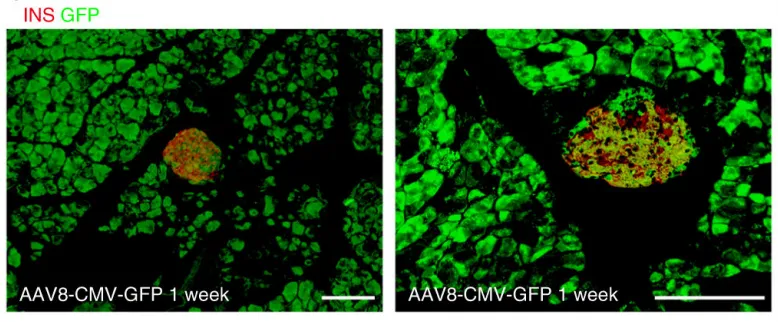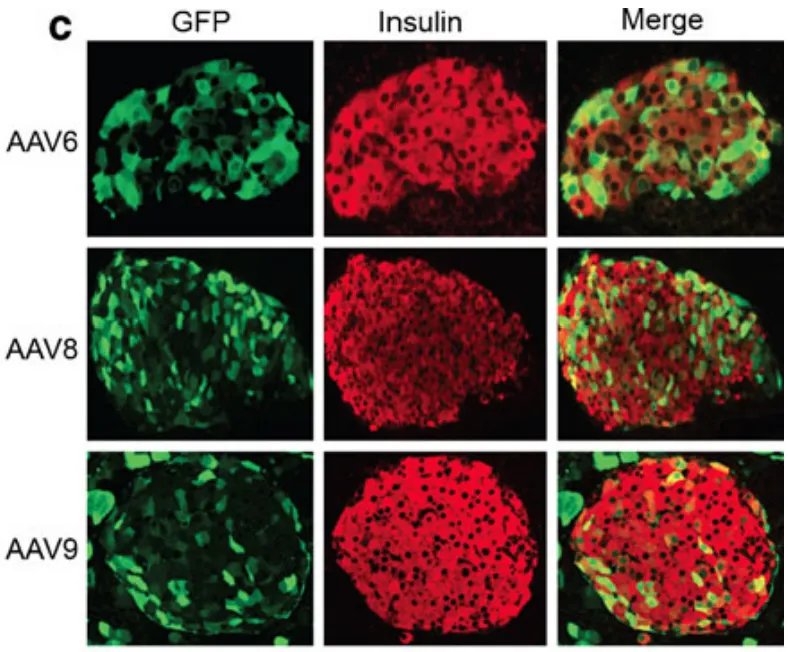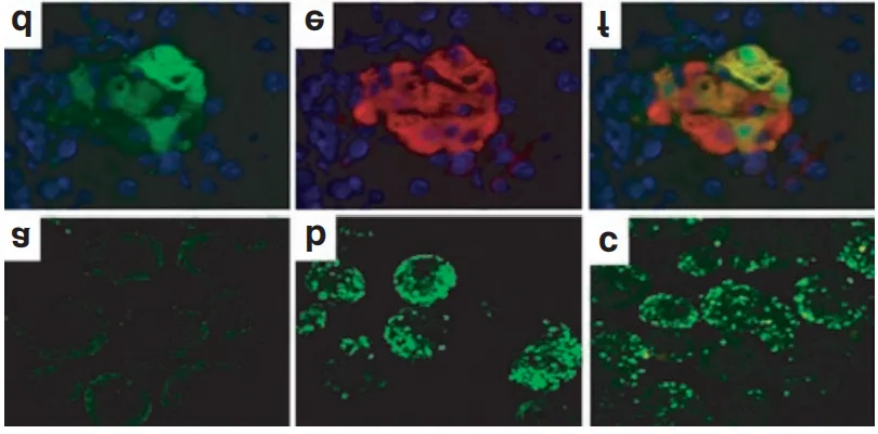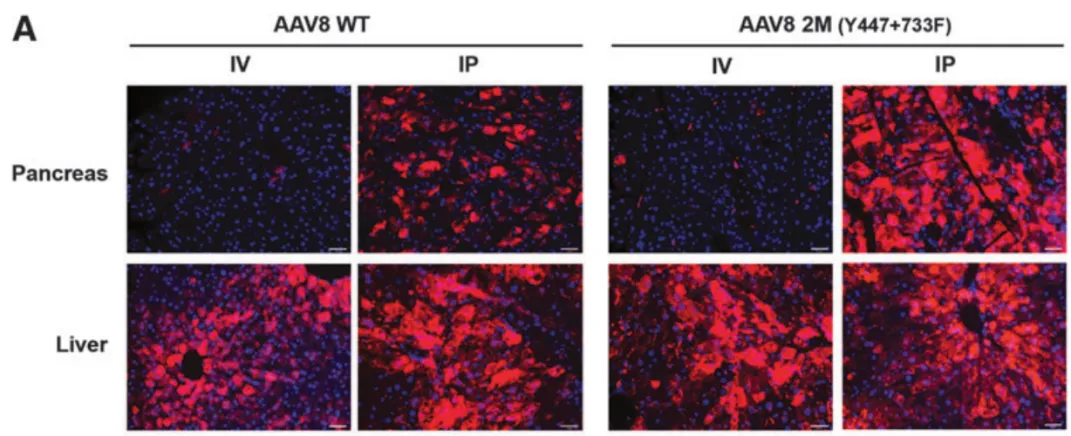- E-mail:BD@ebraincase.com
- Tel:+8618971215294
The pancreas is a critical endocrine organ in the body, playing a role in digestion, glucose metabolism, and lipid metabolism. Its dysfunction can lead to diseases such as diabetes and pancreatic cancer. Therefore, identifying virus vectors that can specifically target the pancreas is crucial for metabolic and cancer research. Conducting in vivo genetic engineering on the pancreas, particularly gene transfer to β-cells, could help us study and elucidate the physiological and pathological roles of key genes in the onset and progression of diabetes.
Studies have shown that AAV vectors demonstrate higher transduction efficiency in the pancreas compared to adenoviral and lentiviral vectors. Among single-stranded AAV vectors, serotypes 8 (AAV8) and 9 (AAV9) exhibit strong transduction efficiency in both the exocrine and endocrine regions of the pancreas when administered systemically, intrapancreatically, intraductally, or via pancreatic vasculature.
AAV8 and Y447F+Y733F-AAV8 are currently the most commonly used serotypes for pancreatic infection.

Figure 1: Vector expression of different AAV serotypes in the gastrocnemius muscle.
When AAV carrying the Sox9 promoter (ductal cell-specific) to mediate Cre recombinase expression is injected into R26R-Tomato reporter mice, ductal cells are specifically and efficiently labeled. When AAV carrying the RIP promoter (insulin promoter) to mediate recombinant SMAD7 expression is injected, SMAD7 is found to be specifically overexpressed in pancreatic β-cells. When AAV carrying the CMV promoter (cytomegalovirus promoter) to mediate GFP expression is injected, GFP expression is observed throughout the entire pancreas.
| Promoter Names | Infection Characteristics | |
|---|---|---|
| Sox9 | Duct cell-specific promoter | Ductal Cells |
| RIP/mlP | Insulin promoter | Islet β-Cells |
| CMV | Cytomegalovirus promoter | Broad Infection |
Currently, there are two main methods for AAV infection of the pancreas:
(1) Injection via the bile duct:
This method involves using microclamps to block the proximal hepatic and duodenal ends of the bile-pancreatic duct. The virus is then delivered into the bile duct using a pump to infect the pancreas.
(2) Intraperitoneal injection:
This method is more convenient. However, it exhibits weaker tissue specificity compared to the bile duct injection method.
Serotypes: AAV6, AAV8, and AAV9
Promoter: CAG
Experimental Animals: Mice
Injection Protocol: Pancreatic duct injection, Dose: 3×1010 to 3×1012 vg per mouse, Expression duration-4 weeks
Experimental Results: Compared to AAV9, AAV6 and AAV8 transduced more pancreatic cells at all tested doses (3E+10/3E+11/3E+12). At the highest dose (3.0×1012 vg/per mouse), transduction was achieved across all islets in the pancreas.

Figure 2: Transduction of pancreatic cells via AAV injection through the pancreatic duct.
Case 2: AAV8-mediated expression of the interleukin-4 gene in β-cells
Serotype: AAV2/8
Promoter: mIP (mouse insulin promoter)
Experimental Animals: NOD (Non-Obese Diabetic) mice
Injection Protocol: Intraperitoneal injection, 4.0×1012vg per mouse, Expression duration - 2 weeks
Experimental Results: The mouse insulin promoter (mIP) in the dsAAV vector demonstrated β-cell specificity, effectively driving AAV-mediated expression of enhanced green fluorescent protein (eGFP) specifically in pancreatic β-cells. In young female NOD mice, the infection efficiency of dsAAV8-mIP-eGFP in pancreatic β-cells and its ability to mediate eGFP expression were comparable to those observed in normal BALB/C mice, achieving β-cell-specific expression.

Figure 3: Enhanced Green Fluorescent Protein (eGFP) Expression in Pancreatic Islets
Serotype: AAV2/8
Promoter: CBA (chicken β-actin promoter)
Experimental Animals: Mice
Injection Protocol:Intraperitoneal injection, 1.0×1011 to 3.0×1011 vg per mouse, Expression duration - 2 weeks
Experimental Results: Compared to intravenous injection, intraperitoneal injection of AAV8 significantly increased transduction efficiency in the pancreas. Using the Y447F+Y733F mutant AAV8 vector (AAV2/8 pan-CBA-mCherry), a dose three times lower (1.0×1011vg per mouse) achieved higher transduction efficiency in the pancreas than previously reported doses (3.0×1011 to 5.0×1011 vg per mouse) with standard AAV8 vectors.

Figure 4: Intraperitoneal Injection of Y447F+Y733F-AAV8 Achieves Higher Transduction Efficiency and Gene Expression Compared to Tail Vein Injection
Case 4: AAV-Mediated Pancreatic Overexpression of Igf1 Inhibits the Progression of Autoimmune Diabetes in Mice
Serotype: AAV2/8
Promoter: mIP (mouse insulin promoter)
Experimental Animals: Mice
Injection Protocol: Pancreatic duct injection, Titer: 1.0×1013 vg/ml, Expression duration: 2 weeks
Experimental Results: To investigate the specific effects of mPGES-2 on β-cell function and glucose metabolism, AAV8-MIP-mPGES-2-GFP was delivered via pancreatic duct injection to achieve β-cell-specific overexpression of mPGES-2. The findings indicated that mPGES-2 plays a significant role in regulating glucose metabolism and β-cell senescence.

Figure 5: Distribution of Viral Infection in the Endocrine and Exocrine Pancreatic Regions
Reference
1、Jimenez V, Ayuso E, Mallol C, et al. In vivo genetic engineering of murine pancreatic beta cells mediated by single-stranded adeno-associated viral vectors of serotypes 6, 8 and 9. Diabetologia. 2011;54(5):1075-1086.
2、Rehman KK, Trucco M, Wang Z, Xiao X, Robbins PD. AAV8-mediated gene transfer of interleukin-4 to endogenous beta-cells prevents the onset of diabetes in NOD mice. Mol Ther. 2008;16(8):1409-1416.
3、Chen M, Maeng K, Nawab A, et al. Efficient Gene Delivery and Expression in Pancreas and Pancreatic Tumors by Capsid-Optimized AAV8 Vectors. Hum Gene Ther Methods. 2017;28(1):49-59.
4、Zhong D, Wan Z, Cai J, et al. mPGES-2 blockade antagonizes β-cell senescence to ameliorate diabetes by acting on NR4A1. Nat Metab. 2022;4(2):269-283.
Brain Case offers various virus packaging customization services. For more information, please contact bd@ebraincase.com.
This article is not authorized for reproduction. If needed, please contact us to obtain the original text.